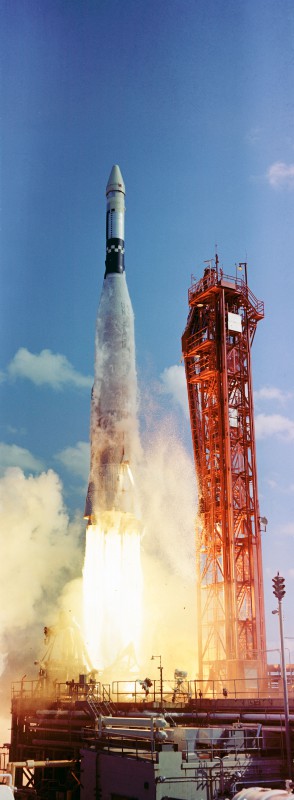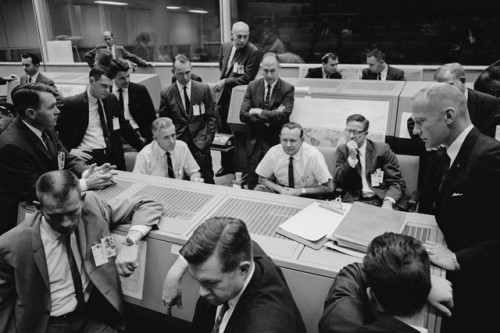
Almost 50 years ago, the United States almost staged its first rendezvous mission between unpiloted and piloted vehicles in low-Earth orbit. An Atlas-Agena target craft was almost successfully launched and two astronauts—Gemini VI crewmen Wally Schirra and Tom Stafford—almost followed it on a voyage which might have pushed America far ahead of the Soviet Union in the race to plant human bootprints on the Moon before the end of the decade.
Almost.
To be fair, the Soviets had managed to bring two manned craft together during the Vostok era, but had not yet accomplished a “true” rendezvous situation. One of the key objectives of Project Gemini—which featured no less than 10 manned missions between March 1965 and November 1966, preceded by two uncrewed test flights—was to practice rendezvous, docking, station-keeping, and spacewalking and to acquire long-duration experience of living and working in the microgravity environment, before the late President John F. Kennedy’s goal of reaching the Moon could be attempted. Yet the success which Gemini VI ultimately became would come at the end of two disappointing months, which saw a rocket explode, a pair of piloted missions combined into one, a vice president fall asleep in the simulator … and a hairy pad abort which almost spelled death for Schirra and Stafford.
Almost.
Flying for longer periods in space, according to NASA flight surgeon Chuck Berry, had “qualified man to go to the Moon.” In August 1965, astronauts Gordo Cooper and Charles “Pete” Conrad returned in good physical shape after eight days in orbit. Next up, in late October, Schirra and Stafford would spend just two days aloft, but would actively bring their Gemini VI craft close to a Lockheed-built Agena-D target vehicle, launched atop an Atlas booster. The importance of the flight was such that both the prime crew and their backups—Virgil “Gus” Grissom and John Young—were highly experienced. Although it would be Tom Stafford’s first mission, he was already recognized as an expert in space rendezvous. Having said this, Grissom wanted command of the first Apollo mission and pursued it relentlessly. In his autobiography, We Have Capture, Stafford noted that although Young sat through simulations with them, Grissom was often absent, racing cars or boats. Following Gemini VI would come the 14-day endurance mission of Gemini VII, sometime early in 1966, crewed by astronauts Frank Borman and Jim Lovell.
All that changed, 49 years ago, today, on 25 October 1965.

Although the so-called Gemini-Agena Target Vehicle (GATV) was a fundamental aid in demonstrating rendezvous, docking, and performing linked exercises in space, doubts about its reliability were prevalent within NASA. Some managers felt that it could not be trusted to execute maneuvers with a docked Gemini, yet Wally Schirra lobbied for it to fly. He also wanted a firing of the Agena’s less powerful secondary propulsion system, but this was not initially incorporated into the Gemini VI flight plan.
First up would be the Agena, mounted atop its Atlas rocket, from Cape Canaveral’s Pad 14, boosted into a 200-mile (320-km) circular orbit. One hundred minutes later, Schirra and Stafford would follow aboard Gemini VI from Pad 19, their Titan II injecting them into a lower orbit. “Two hundred and seventy degrees behind the Agena,” wrote Stafford, “you’d make a series of maneuvers that would eventually raise the orbit of the Gemini to a circular one below the Agena. Then you’d glide up below the Agena on the fourth revolution. At that time the crew would make a series of maneuvers to an intercept trajectory, then break to station-keeping and docking.” This docking would occur over the Indian Ocean—some six hours into the mission—and after which Schirra and Stafford would remain linked for seven hours and return to Earth following their battery-restricted two-day flight. The astronauts wanted to relight the Agena’s engine whilst docked, but NASA managers vetoed it as too ambitious.
The rendezvous, Schirra explained years later, utilized the Hohmann Transfer: “the most efficient, quickest, and prettiest way to do a rendezvous. But it is also intolerant of error. If you blow the rendezvous, fuel and time constraints won’t permit another try.” During their training in the second half of 1965, the astronauts practised maneuvers again and again, plotting them on boards. In total, they did more than 50 practice runs and spent hours rehearsing the docking with the Agena in a Houston trainer. “Housed in a six-story building,” wrote Schirra in his memoir, Schirra’s Space, “it consisted of a full-scale Gemini cockpit and the docking adaptor of the Agena. They were two separate vehicles in an air-drive system that moved back and forth free of friction. We exerted control in the cockpit with small thrusters, identical to those on the spacecraft. We could go up and down, left and right, back and forth. The target could be maneuvered in those planes as well, though it was inert. It would move if we pushed against it, just as we assumed the Agena would do in space.”
On one occasion, Schirra hosted Vice President Hubert Humphrey in the pilot’s seat. Humphrey asked if their voices could be heard from outside the trainer. When Schirra replied that it was sound-proofed, Humphrey asked if Schirra minded him taking a nap. When Humphrey awoke, he asked Schirra to tell him what had happened so that he could tell the people outside. “I was a fan of Hubert Humphrey from that day on,” wrote Schirra.
Gemini VI was the last of the series to run solely on battery power, thus limiting the two astronauts to no more than 48 hours in space. However, by September 1965, NASA was pushing for just one day aloft, if all objectives were completed. “Secondary” experiments were kept to a bare minimum. Schirra’s attitude was that rendezvous was a significant challenge and left no time to “play” with experiments.
Early on 25 October, out at Pad 14, a team from General Dynamics oversaw the final hours of the Atlas-Agena countdown. The Atlas booster, tipped with the thin, pencil-like Agena, was scheduled to fly at precisely 10:00 a.m. EDT. Meanwhile, Schirra—who was struggling to give up smoking—lit up a Marlboro during the ride to Pad 19. He felt, wrote Stafford, that “he could survive a twenty-four-hour flight without getting the shakes.” At length, General Dynamics launch manager Thomas O’Malley pressed the firing button for the Atlas-Agena at 10:00 a.m., and the first half of the mission almost got underway.
Almost.
There seemed little reason to doubt that the Agena would fly perfectly. The countdown had gone well. The Agena had a heritage of 140 previous flights since 1959, and its reliability was very good. It would separate from the Atlas high above the Atlantic Ocean, then fire its engine over Ascension Island to boost itself into orbit. Finally, at 11:41 a.m., Schirra and Stafford would ride their Titan into space to initiate the rendezvous.

Almost immediately after the Atlas-Agena lifted off, things started to go catastrophically wrong. It would appear that the Agena separated properly from its carrier rocket, but seemed to “wobble” a little, despite the efforts of its attitude-control mechanism to steady it. Right on time, its engine flared to life … and nothing more was heard. It had reached an altitude of about 150 miles (240 km) and was 500 miles (800 km) downrange of the Cape. Fourteen minutes after liftoff, specialists at the Bermuda radar station expected to receive tracking. They saw nothing, save the signatures of five large fragments.
Out at Pad 19, Schirra and Stafford were listening to the updates and were puzzled. “Maybe it’s the tracking station,” Schirra speculated. “Let’s wait for Ascension Island.” Their countdown was held, but at length Ascension, too—in the mid-Atlantic—saw nothing. Later, the Carnarvon station in Australia also saw nothing, and the assumption had to be made that the target vehicle had been lost. Subsequent investigation revealed that the Agena had exploded, due to a pre-launch change in the oxidizer feed sequence protocol. If it represented a programmatic failure with the vehicle, the issue spelled trouble for Project Gemini, which depended upon the Agena as its primary rendezvous target. In the meantime, a disappointed Schirra and Stafford were extracted from Gemini VI and headed off into town with Chief Astronaut Al Shepard and backup crewman John Young.
“Boys,” Shepard told them, “what we need is a good party!”
The second part of this article will appear tomorrow.
Want to keep up-to-date with all things space? Be sure to “Like” AmericaSpace on Facebook and follow us on Twitter: @AmericaSpace




Schirra lit up a cigarette on the way to the launch pad? Weren’t they sealed in their spacesuits on pure oxygen?
In his autobiography “We Have Capture”, Tom Stafford writes: “We had breakfast in the crew quarters, then headed out to the suiting trailer at Pad 16. On the trip, Wally lit up a Marlborough. He had not yet given up smoking, figuring he could survive a 24-hour flight without getting the shakes”. Schirra lit up his cigarette on the way to the suiting trailer at Pad 16, hence this was prior to suiting up.
Hope this clarifies the point.